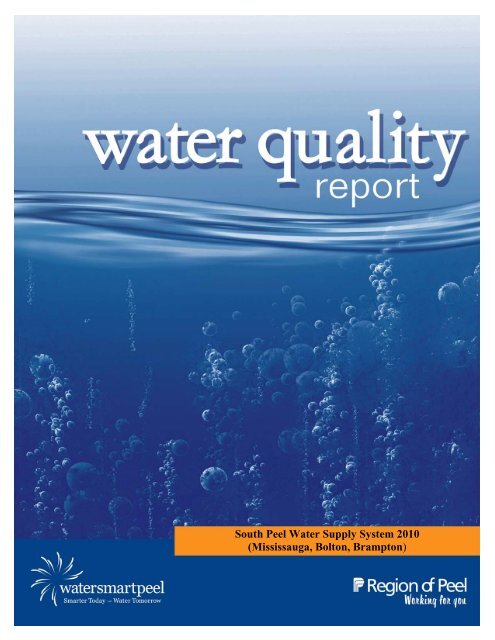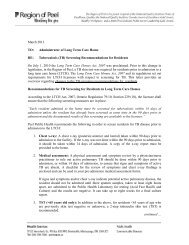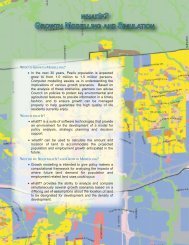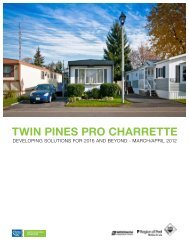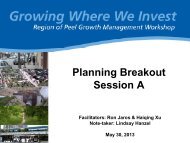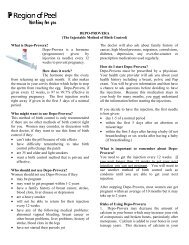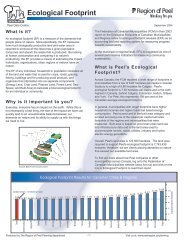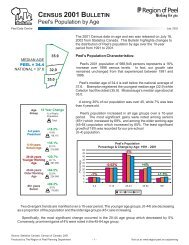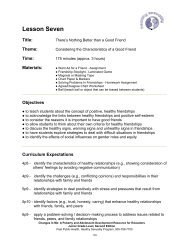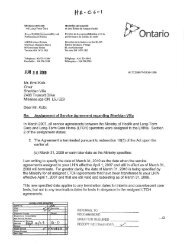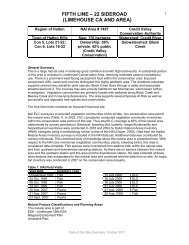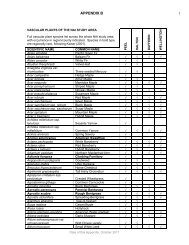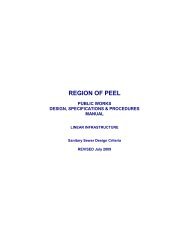South Peel Water Supply System 2010 ... - Region of Peel
South Peel Water Supply System 2010 ... - Region of Peel
South Peel Water Supply System 2010 ... - Region of Peel
You also want an ePaper? Increase the reach of your titles
YUMPU automatically turns print PDFs into web optimized ePapers that Google loves.
<strong>South</strong> <strong>Peel</strong> <strong>Water</strong> <strong>Supply</strong> <strong>System</strong> <strong>2010</strong><br />
(Mississauga, Bolton, Brampton)
TABLE OF CONTENTS<br />
Our Vision 2<br />
1. General Drinking <strong>Water</strong> <strong>System</strong> Information 4<br />
1.1 Where does the water come from? 4<br />
1.2 Expenditure Information 5<br />
2. How is the <strong>Water</strong> Treated? 7<br />
2.1 Lakeview <strong>Water</strong> Treatment Plant 7<br />
2.2 Lorne Park <strong>Water</strong> Treatment Plant 10<br />
2.3 Conventional <strong>Water</strong> Treatment Process description 13<br />
2.4 Ozone, Biologically Activated Carbon and Membrane (OBM) 16<br />
3. Ontario Drinking <strong>Water</strong> Compliance Information 18<br />
3.1 Annual <strong>Water</strong> Quality Reports 18<br />
3.2 Sampling and Testing 18<br />
3.3 Licensed Operators 19<br />
3.4 <strong>Water</strong> Quality Notification 20<br />
4. How well did we do? 20<br />
4.1 Operation 20<br />
4.2 Customer Service – Quality and Efficiency 24<br />
5. Drinking <strong>Water</strong> Quality Programs 25<br />
5.1 Municipal Drinking <strong>Water</strong> Licensing Program 25<br />
5.2 Source <strong>Water</strong> Protection 26<br />
5.3 Private Well Abandonment Program 27<br />
5.4 <strong>Water</strong> Main Renewal Program 28<br />
5.5 Community Lead Testing Program 29<br />
5.6 <strong>Water</strong> Main Flushing Program 30<br />
5.7 Hydrant Inspection Program 30<br />
5.8 Drinking <strong>Water</strong> Sampling Station Program<br />
Appendix A<br />
30<br />
Summary <strong>of</strong> <strong>Water</strong> Quality Parameter<br />
Appendix B<br />
31<br />
Frequently Asked Questions on <strong>Water</strong> Quality 41<br />
Report Accessibility 44<br />
2
Our Vision<br />
“To be recognized as the Industry Leader in Public Works”<br />
The <strong>Region</strong>al Municipality <strong>of</strong> <strong>Peel</strong> takes pride in ensuring that its residents are provided with<br />
clean and safe drinking water.<br />
The <strong>Region</strong> <strong>of</strong> <strong>Peel</strong> treats water to prevent contamination and regularly tests its quality. In the<br />
year <strong>2010</strong> <strong>Peel</strong> has provided its consumers with excellent quality water. A number <strong>of</strong> tests were<br />
performed on thousands <strong>of</strong> water samples collected throughout the year, including testing for<br />
microbiological, inorganic and organic parameters. The <strong>2010</strong> results <strong>of</strong> the tests performed by<br />
the <strong>Region</strong> <strong>of</strong> <strong>Peel</strong> confirm high quality <strong>of</strong> drinking water and have been consolidated in this<br />
annual report.<br />
If experiencing difficulty accessing or viewing the <strong>2010</strong> data results, please contact <strong>Water</strong><br />
Quality Team at 905-791-7800 ext 4685 or at <strong>Water</strong>QualityInquiries@peelregion.ca.<br />
3
1. General Drinking <strong>Water</strong> <strong>System</strong> Information<br />
1.1 Where does the water come from?<br />
The Cities <strong>of</strong> Mississauga and Brampton and the Town <strong>of</strong> Bolton, a population <strong>of</strong> approximately<br />
1.3 million people, obtain their drinking water from Lake Ontario. Raw water from the lake is<br />
pumped into two surface water treatment plants, Lakeview <strong>Water</strong> Treatment Plant (WTP) and<br />
Lorne Park <strong>Water</strong> Treatment Plant (WTP), from intake pipes located up to two kilometres <strong>of</strong>f<br />
shore. The Lakeview and Lorne Park plants are owned by the <strong>Region</strong> <strong>of</strong> <strong>Peel</strong> and operated by<br />
the Ontario Clean <strong>Water</strong> Agency (OCWA). Each year, the plants produce approximately 204<br />
billion litres <strong>of</strong> water. A portion <strong>of</strong> water produced is also pumped into York <strong>Region</strong>. Both<br />
plants are classified as Class IV systems.<br />
Distribution <strong>System</strong>/ Storage Facilities<br />
The distribution system carries water from the plants to the Cities <strong>of</strong> Brampton, Mississauga and<br />
Town <strong>of</strong> Bolton through a series <strong>of</strong> pipes ranging in size from 350mm to over 1200mm in<br />
diameter.<br />
The <strong>South</strong> <strong>Peel</strong> water distribution system consists <strong>of</strong> 4,109 kilometres <strong>of</strong> water mains, 40,934<br />
mainline valves, 24,907 fire hydrants and 299,856 water services.<br />
(<strong>2010</strong> - <strong>South</strong> <strong>Peel</strong> <strong>Water</strong> Distribution <strong>System</strong>)<br />
There are a total <strong>of</strong> 12 reservoirs, 4 elevated tanks, and 2 standpipes in Brampton, Mississauga<br />
and Bolton that hold and store water.<br />
Some <strong>of</strong> the maintenance activities performed at the <strong>South</strong> <strong>Peel</strong> distribution system include:<br />
• water main break repairs<br />
• hydrant maintenance and repairs<br />
• valve maintenance and repairs<br />
• water service line installation/replacement/repairs, and<br />
• customer service calls (water quality/quantity, turn <strong>of</strong>f/on, pressure testing, etc.)<br />
4
1.2 Expenditure Information:<br />
<strong>Region</strong> <strong>of</strong> <strong>Peel</strong> staff determine capital spending priorities to eliminate unnecessary expenditures<br />
while maintaining its infrastructure.<br />
Table 1.2.1: Significant Expenses for Lakeview Drinking <strong>Water</strong> <strong>System</strong><br />
Activity Description Activity Type Approximate Expenditure<br />
<strong>Water</strong> Main Break Repairs Repair $1,672,000<br />
Valve Repairs Repair $256,000<br />
Fire Hydrant Repairs Repair $439,000<br />
<strong>Water</strong> Service Repairs Repair $429,000<br />
Service Box Repairs Repair $265,000<br />
<strong>Water</strong> Main Renewal and Rehabilitation Repair $33,737,000<br />
19-26 Filter Basement Repair $9,000<br />
OBM Vacuum Pumps Repair $1,000<br />
LL3 WW Transfer Pumps & Motor #2 Repair $12,000<br />
LL3 WW Transfer Pumps & Motor #3 Repair $11,000<br />
Re-Coat Trains 42, 44, 45 Repair $42,000<br />
Beckett Sproule Facility: Cells 1 and 2 Rehabilitation Projects Repair $2,600,000<br />
Chlorine Building - Regulators Replacement $73,000<br />
Fire Hydrant Replacements Replacement $105,000<br />
<strong>Water</strong> Service Replacements Replacement $47,000<br />
Valve Replacements Replacement $121,000<br />
Service Box Replacement-Vactor Replacement $383,000<br />
Granular Activated Carbon (GAC) Replacement Replacement $44,000<br />
Standby Power Optimization Installation $5,000<br />
HL3 - High Voltage Upgrades Installation $10,000<br />
Valve Installation Installation $64,000<br />
North Brampton – Pumping Station Upgrade Project Installation $900,000<br />
East Brampton – Pumping Station Upgrade Project Installation $3,800,000<br />
Mayfield West Elevated Tank and Feeder Main Installation $7,980,000<br />
Beckett Sproule 2100mm Feeder Main Installation $59,000,000<br />
Tullamore 1200mm Feeder Main (Contract 1) Installation $4,835,000<br />
Countryside Drive 600mm Feeder Main Installation $8,750,000<br />
5
Table 1.2.2: Significant Expenses for Lorne Park Drinking <strong>Water</strong> <strong>System</strong><br />
Activity Description Activity Type<br />
Approximate<br />
Expenditure<br />
<strong>Water</strong> Main Break Repairs Repair $1,114,000<br />
Valve Repairs Repair $171,000<br />
Fire Hydrant Repairs Repair $293,000<br />
<strong>Water</strong> Service Repairs Repair $286,000<br />
Service Box Repairs Repair $177,000<br />
<strong>Water</strong> Main Renewal and Rehabilitation Repair $22,491,000<br />
Major Pump Improvements Repair $17,000<br />
Settling Tanks 9-12 Inspection and Repair Repair $61,000<br />
Trac-Vac Improvements Repair $6,000<br />
HVAC Balancing Repair $4,000<br />
Filters 9-12 Gate Repairs Repair $57,000<br />
Holding Tanks 1 and 2 Inlet Gates Replacement $39,000<br />
Sludge Gallery Valves and Actuators Replacement $62,000<br />
Fire Hydrant Replacements Replacement $70,000<br />
<strong>Water</strong> Service Replacements Replacement $31,000<br />
Valve Install/Replacements Replacement $80,000<br />
Service Box Replacement-Vactor Replacement $256,000<br />
900 mm High Lift Discharge Valve Replacement Replacement $31,000<br />
West Brampton Pumping Station and Reservoir- Project Installation $42,100,000<br />
West Brampton 1500 mm Feeder Main Installation $47,900,000<br />
6
2. How is <strong>Water</strong> Treated?<br />
2.1 Lakeview <strong>Water</strong> Treatment Plant<br />
(Drinking <strong>Water</strong> Works Number 210000568)<br />
Figure 1: Lakeview <strong>Water</strong> Treatment Plant<br />
The Lakeview <strong>Water</strong> Treatment Plant serves the Eastern sections <strong>of</strong> Mississauga and Brampton,<br />
and the community <strong>of</strong> Bolton. Operated as a conventional water treatment plant, Lakeview WTP<br />
also has an advanced treatment train consisting <strong>of</strong> ozone, biologically activated carbon<br />
contactors (BACC) and membrane filtration.<br />
7
Conventional Treatment<br />
Conventional treatment consists <strong>of</strong> the following steps: coagulation, flocculation, sedimentation,<br />
filtration, and disinfection.<br />
Ozone, Biologically Activated Carbon Contactor and Membrane Filtration (OBM) Treatment<br />
The OBM treatment process consists <strong>of</strong> ozone, biologically active carbon contactor treatment<br />
and membrane filtration.<br />
(Please refer to Figure 2 below for the Lakeview <strong>Water</strong> Treatment Plant Process Diagram)<br />
The Western parts <strong>of</strong> Mississauga and Brampton are serviced by the Lorne Park <strong>Water</strong><br />
Treatment facility. Several water mains link the two areas, allowing water to transfer from either<br />
east to west or west to east.<br />
The chemicals used at the Lakeview <strong>Water</strong> Treatment Plant over the reporting period were<br />
aluminum sulphate (Alum), chlorine gas, hydr<strong>of</strong>luosilicic acid, polymer, sodium hypochlorite,<br />
sodium hydroxide, sodium bisulphite, citric acid, and ozone gas.<br />
Aqua ammonia is applied at the Airport Road Pumping Station only, to supply chloraminated<br />
water to York <strong>Region</strong>.<br />
http://www.peelregion.ca/pw/water/water-trtmt/lakeview.htm<br />
8
Conventional OBM<br />
Coagulation/Flocculation/Sedimentation<br />
Removal <strong>of</strong><br />
suspended and<br />
dissolved solids<br />
to improve filter<br />
performance<br />
Filtration (Sand/Gravel/GAC)<br />
Removal <strong>of</strong> small<br />
particles,<br />
organics, and<br />
microorganisms<br />
Lake Ontario<br />
Screening<br />
Chlorination<br />
(Disinfection)<br />
Inactivation <strong>of</strong><br />
bacteria/disease<br />
causing organisms<br />
Fluoridation<br />
Protects teeth<br />
from cavities<br />
Consumer<br />
Prevents fish,<br />
sticks and plants<br />
from entering and<br />
damaging<br />
equipment<br />
Figure 2: Lakeview <strong>Water</strong> Treatment Plant Process<br />
Ozonation<br />
BACC Filters<br />
Membranes<br />
Kills bacteria<br />
and breaks<br />
down large<br />
particles<br />
Removes<br />
organic<br />
materials from<br />
water by<br />
adsorption<br />
Removal <strong>of</strong> small<br />
particles and<br />
microorganisms<br />
9
2.2 Lorne Park <strong>Water</strong> Treatment Plant<br />
(Drinking <strong>Water</strong> Works Number 210001317)<br />
Figure 3: Lorne Park <strong>Water</strong> Treatment Plant<br />
The Lorne Park <strong>Water</strong> Treatment Plant is located on the north shore <strong>of</strong> Lake Ontario and is a<br />
conventional treatment plant.<br />
Conventional Treatment<br />
Conventional treatment consists <strong>of</strong> the following steps: coagulation, flocculation, sedimentation,<br />
filtration, and disinfection.<br />
(Please refer Figure 4 below for the Lorne Park <strong>Water</strong> Treatment Process flow)<br />
10
Lake Ontario<br />
Filtration (Sand/Gravel/GAC)<br />
Ultra Violet Light (UV)<br />
Removal <strong>of</strong> small<br />
particles, organics,<br />
and microorganisms<br />
Disinfection<br />
Inactivates<br />
pathogens and<br />
controls taste<br />
and odour<br />
Chlorination<br />
Inactivation <strong>of</strong><br />
bacteria/disease<br />
causing organisms<br />
Fluoridation<br />
Protects teeth<br />
from cavities<br />
Figure 4: Lorne Park <strong>Water</strong> Treatment Plant Process<br />
Screening<br />
Prevents fish,<br />
sticks and<br />
plants from<br />
entering and<br />
damaging<br />
equipment<br />
Coagulation/Flocculation/Sedimentation<br />
Removal <strong>of</strong><br />
suspended and<br />
dissolved solids<br />
to improve filter<br />
performance<br />
Consumer<br />
11
To ensure an adequate supply <strong>of</strong> safe drinking water to an increasing population, in 2009,<br />
construction began to enlarge the plant’s capacity to 500 million litres per day. The upgrades to<br />
the plant include installation <strong>of</strong> modern, state-<strong>of</strong>-the-art, membrane filtration and an ultraviolet<br />
(UV) light treatment system to inactivate pathogens and control the tastes and odours<br />
occasionally found in the water.<br />
Every effort has been taken to minimize impacts by implementing a design that uses the existing<br />
footprint <strong>of</strong> the plant.<br />
The chemicals used at the Lorne Park plant during the reporting period were acidified aluminum<br />
sulphate (Alum), aluminum chlorohydrate (ACH), hydr<strong>of</strong>luosilicic acid, sodium hypochlorite<br />
and sodium bisulphite.<br />
http://www.peelregion.ca/pw/water/water-trtmt/lorne-park.htm<br />
12
2.3 Conventional <strong>Water</strong> Treatment Process Description<br />
Lake Ontario is the source for the <strong>South</strong> <strong>Peel</strong> Drinking <strong>Water</strong> <strong>System</strong>. As the<br />
lake water enters the intake, it can be chlorinated. The chlorine kills bacteria and<br />
prevents zebra mussels from growing in the intake pipe and obstructing the flow.<br />
As the water enters the treatment facility, it passes through the travelling screen.<br />
The screen prevents items such as fish, sticks and aquatic plants from entering<br />
the treatment facility and damaging equipment.<br />
Low lift and backwash pumps are located in several pump Stations.<br />
Low lift pumps draw the lake water into the treatment plant.<br />
Coagulation assists with the removal <strong>of</strong> turbidity and suspended matter (particles) in the water.<br />
A coagulant (Alum or ACH) is added to the water. The rapid mixer thoroughly mixes the<br />
coagulant with the water to help form sticky particles.<br />
13
Flocculation is the process <strong>of</strong> slow mixing that helps the sticky particles collide with each other,<br />
forming larger and heavier particles called floc.<br />
In the sedimentation process, floc particles are removed from the<br />
water by inclined plate settlers. The water is slowed down in large<br />
tanks to allow particles to settle to the bottom. The settled solids<br />
are removed and transferred to the wastewater treatment facility.<br />
Filtration removes remaining particles and chlorine-resistant bacteria and reduces the levels <strong>of</strong><br />
compounds that can cause tastes and odours. The water travels through layers <strong>of</strong> granular<br />
activated carbon, sand and gravel. <strong>Water</strong> starts at the top <strong>of</strong> the filter and moves down by<br />
gravity.<br />
When needed, the filters are backwashed (cleaned). Clean water<br />
is pumped up and through the filter media, in a reverse flow,<br />
lifting and flushing out the floc particles that have accumulated in<br />
the filter. The backwash water is treated in the backwash<br />
treatment facility prior to being discharged into the lake.<br />
The process <strong>of</strong> disinfection destroys harmful disease-causing organisms such as E. coli and<br />
Giardia. Chlorine is the most common disinfectant used in water treatment.<br />
14
Fluoride is added to the finished water to prevent cavities in our teeth. The finished water is<br />
then stored in a reservoir and distributed into our communities through a series <strong>of</strong> pumps and<br />
reservoirs.<br />
Diesel-powered generators provide auxiliary or standby power for the facility. Standby power<br />
ensures we can provide water in case <strong>of</strong> an emergency such as a massive power failure.<br />
The water flows through water mains to houses, apartments, and schools, commercial and<br />
industrial premises.<br />
Note: To download a water treatment poster and to learn about the water treatment process, visit:<br />
http://www.peelregion.ca/pw/water/water-trtmt/water-treatment-process.htm<br />
15
2.4 Ozone, Biologically Activated Carbon and Membrane (OBM) <strong>Water</strong> Treatment Process<br />
Description<br />
Low lift pumps draw water from Lake Ontario into the treatment plant.<br />
Ozone gas is then bubbled through the water in the Ozone Contactors. Ozone kills<br />
bacteria and also helps to break down substances that cause tastes and odours so that<br />
they are more easily removed in the next treatment step.<br />
The water then passes into the Biologically Active Carbon<br />
Contactors (BACC). These specially designed contactors remove<br />
the biodegradable organic matter produced by the activity <strong>of</strong> the<br />
ozone process. The BAC contactors are very good at adsorbing<br />
organic matter from the water and this removal process keeps the water stable after treatment by<br />
minimizing re-growth <strong>of</strong> bacteria in the distribution system.<br />
In the next treatment process, water passes through the Membrane Ultra Filtration system.<br />
These are specially designed water filters with very small pores that the water is pulled through.<br />
The membrane filters are so efficient that they are capable <strong>of</strong><br />
removing microorganisms and producing water with very little<br />
turbidity.<br />
16
Filtered water is directed to the Weir Box. The weir box stores water and is also the location<br />
where chlorine and fluoride are added.<br />
Treated water from both the conventional treatment and the OBM treatment processes flows by<br />
gravity into the water Storage Reservoir.<br />
The water must remain in the storage reservoir until adequate disinfection has occurred. <strong>Water</strong><br />
leaves the reservoir by way <strong>of</strong> High Lift Pumps and enters the distribution system.<br />
17
3. Ontario Drinking <strong>Water</strong> Compliance Information<br />
Drinking water quality in <strong>Peel</strong> is regulated by the Ontario government through the Ministry <strong>of</strong><br />
the Environment (MOE). The Ontario drinking water legislation sets requirements for municipal<br />
system owners with regards to operation, level <strong>of</strong> treatment, sampling and testing, licensing <strong>of</strong><br />
staff and water quality notification.<br />
3.1 Annual <strong>Water</strong> Quality Reports<br />
To comply with the Ontario drinking water regulation under the Safe Drinking <strong>Water</strong> Act, 2002,<br />
the <strong>Region</strong> <strong>of</strong> <strong>Peel</strong> prepares Annual <strong>Water</strong> Quality Reports providing information on quality <strong>of</strong><br />
water supplied and a Summary Report regarding the operation <strong>of</strong> the drinking water systems.<br />
The Summary Report under Schedule 22 <strong>of</strong> Ontario Regulation 170/03 includes a statement <strong>of</strong><br />
compliance <strong>of</strong> the <strong>Region</strong> <strong>of</strong> <strong>Peel</strong>’s drinking water systems with the terms and conditions <strong>of</strong> the<br />
regulations under the Safe Drinking <strong>Water</strong> Act, 2002, and a summary <strong>of</strong> the quantities and flow<br />
rates <strong>of</strong> water supplied. This report is made available to <strong>Region</strong>al Council by March 31 <strong>of</strong> each<br />
year.<br />
The Annual <strong>Water</strong> Quality Reports and Summary Report are made available to the public to<br />
ensure <strong>Peel</strong> consumers are kept informed. Each year, the reports are posted on the regional web<br />
site and electronic or hard copies may be obtained upon request.<br />
The <strong>Region</strong> places an ad in the local newspapers to inform its consumers about the availability <strong>of</strong><br />
the Annual <strong>Water</strong> Quality Reports.<br />
3.2 Sampling and Testing<br />
In accordance with the drinking water legislation, drinking water systems are required to monitor<br />
their water quality to ensure it meets provincial standards.<br />
18
<strong>Peel</strong> regularly samples and tests raw, treated and distribution system water for a number <strong>of</strong><br />
microbiological, chemical and radiological parameters. The <strong>Region</strong> has always had an extensive<br />
water sampling and monitoring program to better understand the quality <strong>of</strong> source water, ensure<br />
effective treatment processes, and to diligently monitor and protect the drinking water supply.<br />
Sampling and testing is conducted by trained and qualified operators, who collect water samples<br />
from various sampling sites throughout the <strong>Region</strong> and immediately test them for first water<br />
safety indicators. Samples are also collected for laboratory analysis for more than 150 health<br />
related and aesthetic parameters.<br />
The Ministry <strong>of</strong> the Environment (MOE) requires that all drinking water testing laboratories be<br />
accredited by the Standards Council <strong>of</strong> Canada (SCC) based on pr<strong>of</strong>iciency evaluation conducted<br />
by the Canadian Association for Laboratory Accreditation (CALA) as well as licensed by the<br />
MOE for all drinking water tests performed.<br />
<strong>Peel</strong> operates its own laboratory for chemical analyses and also subcontracts analytical testing to<br />
other area laboratories. All laboratories used by the <strong>Region</strong> are accredited by the SCC, licensed<br />
by the MOE, and adhere to strict drinking water sample collection, handling and transport<br />
protocols and procedures.<br />
3.3 Licensed Operators<br />
All treatment plant and maintenance operators and technical staff have appropriate <strong>Water</strong><br />
Treatment, <strong>Water</strong> Distribution and <strong>Water</strong> Quality Analyst certification, as required by Ontario<br />
drinking water legislation. The training and certification program ensures that all operators are<br />
certified to industry recognized standards. <strong>Peel</strong> has established a continuing education program<br />
for all staff responsible for operating drinking water systems. This helps operators to gain<br />
knowledge <strong>of</strong> the latest treatment technologies and advanced processes and to effectively<br />
maintain system water quality and quantity.<br />
19
3.4 <strong>Water</strong> Quality Notification<br />
In compliance with the regulatory requirements, <strong>Peel</strong> reports every adverse water quality event to<br />
the Ministry <strong>of</strong> the Environment and Ministry <strong>of</strong> Health and immediately initiates corrective<br />
action to address the potential problem. <strong>Peel</strong> has established a notification protocol for reporting<br />
<strong>of</strong> adverse water quality events and makes these reports and data publicly available in the Annual<br />
<strong>Water</strong> Quality Reports.<br />
4. How well did we do?<br />
4.1 Operation<br />
To protect the health <strong>of</strong> the public and to ensure consumers receive clean and safe water, the<br />
Ministry <strong>of</strong> the Environment (MOE) has established the Ontario Drinking <strong>Water</strong> Quality<br />
Standards (ODWS). These standards are set to ensure the water is free <strong>of</strong> disease causing<br />
organisms and hazardous chemicals. In <strong>2010</strong>, the <strong>Region</strong> monitored water quality by<br />
undertaking over 85,000 process samples and tests to ensure a safe and clean water supply.<br />
Appendix A provides a full summary <strong>of</strong> the water quality test results.<br />
The <strong>Region</strong> <strong>of</strong> <strong>Peel</strong> is proud to report that for the year <strong>2010</strong>, all drinking water samples met<br />
ODWS. The MOE performs annual inspections on all municipal drinking water systems. Based<br />
on the inspection findings, the MOE issues score cards. The score is based upon the questions<br />
posed by the Ministry Inspector during each inspection. The <strong>South</strong> <strong>Peel</strong> drinking water systems’<br />
(Lakeview and Lorne Park) overall performance is excellent, and for the past three inspection<br />
years has been in the 90 th percentile.<br />
20
Year <strong>of</strong> Inspection<br />
<strong>2010</strong><br />
2009<br />
2008<br />
<strong>South</strong> <strong>Peel</strong> WTP MOE Inspection Rating<br />
94.43<br />
93.28<br />
0 20 40 60 80 100<br />
Rating (%)<br />
Figure 5: <strong>South</strong> <strong>Peel</strong> WTP MOE Inspection Rating Graph<br />
Lorne Park WTP<br />
Lakeview WTP<br />
94.23<br />
92.99<br />
99.12<br />
99.14<br />
21
Event<br />
Date<br />
During the period <strong>of</strong> January 1 through December 31, <strong>2010</strong>, the Lakeview <strong>Water</strong> Treatment<br />
system met all the provincial requirements and ODWS except for the following occasions:<br />
TABLE 4.1.1 Summary <strong>of</strong> Adverse Events - Lakeview Drinking <strong>Water</strong> <strong>System</strong> - <strong>2010</strong><br />
Event Location<br />
Parameter/<br />
Process Upset<br />
Result<br />
Unit <strong>of</strong><br />
Measure<br />
Mar 5 Lakeview WTP (TW) Sodium 22 mg/L<br />
Jun 19<br />
988 Burnhamthorpe Rd<br />
East<br />
Jun 23 Lakeview WTP<br />
Free Chlorine<br />
Residual<br />
Alum Flow<br />
Interruption<br />
0 mg/L<br />
N/A N/A<br />
Jun 23 1109 Runningbrook Dr Total Coliform 6 cfu/100 mL<br />
Jun 29<br />
Burnhamthorpe Rd E at<br />
Westminster<br />
Jun 29 Mayfield Elevated Tank<br />
Jul 2<br />
Jul 5<br />
Jul 19<br />
Aug 11<br />
Nov 5<br />
Dec 5<br />
Burnhamthorpe Rd E &<br />
Corbet Dr<br />
49 Grand Valley,<br />
Brampton (hydrant ID #<br />
2106619)<br />
Airport Rd. & Orlando<br />
Dr. Mississauga<br />
Blow <strong>of</strong>f North <strong>of</strong><br />
Larson Peak<br />
HYD#2 -Elderwood<br />
Place<br />
3177 Corrigan Dr.<br />
Mississauga (hydrant)<br />
cfu = colony forming units<br />
mL = millilitres<br />
L = litres<br />
Total Coliform 2 cfu/100 mL<br />
E. Coli and<br />
Total Coliform<br />
1 and 1 cfu/100 mL<br />
Total Coliform 2 cfu/100 mL<br />
Lead 45.2 µg/L<br />
Free Chlorine 0 mg/L<br />
Total Coliform 3 cfu/100 mL<br />
Total Coliform 3 cfu/100 mL<br />
Total Coliform 4 cfu/100 mL<br />
Corrective Action<br />
Re-sample collected March 5 met<br />
Sodium standard<br />
Samples collected June 19 met<br />
microbiological standards<br />
Re-established coagulant flow<br />
manually. Samples collected on June<br />
23 met microbiological standards<br />
Distribution system flushed June 23.<br />
Re-samples collected on June 23 met<br />
microbiological standards<br />
<strong>Water</strong> main was decommissioned; all<br />
service connections transferred to a<br />
new main. No re-samples taken.<br />
Re-samples collected on June 29 &<br />
30 met microbiological standards<br />
Re-samples collected July 2 met<br />
microbiological standards<br />
Re-samples collected July 5 met<br />
Lead standard<br />
No service connections affected.<br />
<strong>Water</strong> main flushed daily until<br />
receipt <strong>of</strong> test results, which met<br />
microbiological standards.<br />
Re-samples collected August 11 met<br />
microbiological standards<br />
Re-samples collected November 8<br />
met microbiological standards<br />
Hydrant flushed and re-samples<br />
collected on December 5 met<br />
microbiological standards<br />
22<br />
Date<br />
Resolved<br />
Mar 8<br />
Jun 21<br />
Jun 29<br />
Jun 26<br />
Jun 29<br />
Jul 9<br />
Jul 5<br />
Jul 13<br />
Jul 26<br />
Aug 16<br />
Nov 8<br />
Dec 9
Event<br />
Date<br />
During the period <strong>of</strong> January 1 through December 31, <strong>2010</strong>, the Lorne Park <strong>Water</strong> Treatment<br />
Plant met all the provincial requirements and ODWS except on the following occasions:<br />
TABLE 4.1.2 Summary <strong>of</strong> Adverse Events - Lorne Park Drinking <strong>Water</strong> <strong>System</strong> - <strong>2010</strong><br />
Event Location<br />
Feb 6 Lorne Park WTP<br />
May 11<br />
Jun 2<br />
Meadowvale SPS<br />
(7005 Old Derry Rd,<br />
Mississauga)<br />
Commuter Drive,<br />
Brampton<br />
Parameter/<br />
Process Upset Result<br />
Alum Flow<br />
Interruption<br />
Unit <strong>of</strong><br />
Measure<br />
N/A N/A<br />
Total Coliform 4 cfu/100 mL<br />
Total Coliform 5 cfu/100 mL<br />
Jun 23 1238 Erinmore Dr Total Coliform 5 cfu/100 mL<br />
Sep 3<br />
S <strong>of</strong> 2301 Derry Rd<br />
West Hydrant<br />
2026255<br />
Total Coliform 2 cfu/100 mL<br />
Dec 22 Meadowvale area Low Pressure 10 psi<br />
cfu = colony forming units<br />
mL = millilitres<br />
L = litres<br />
psi = pounds per square inch<br />
Corrective Action<br />
Alum flow meter maintenance was<br />
performed, and flow meter was<br />
subsequently replaced.<br />
Re-samples collected May 11 met<br />
microbiological standards<br />
Distribution system was flushed in<br />
affected area on June 2. Re-samples<br />
collected June 2 met microbiological<br />
standards<br />
Distribution system was flushed in<br />
affected area on June 23. Re-samples<br />
collected on June 23 met microbiological<br />
standards<br />
Hydrant flushed on September 3. Resamples<br />
collected September 3 met<br />
microbiological standards<br />
Tested pressure and chlorine residuals at<br />
multiple distribution points. All results<br />
within acceptable range.<br />
23<br />
Date<br />
Resolved<br />
Mar 4<br />
May 14<br />
Jun 9<br />
Jun 26<br />
Sep 7<br />
Dec 22
4.2 Customer Service – Quality and Efficiency<br />
In <strong>2010</strong>, all customer calls were responded to and resolved in a timely manner. <strong>Peel</strong> staff has<br />
made every effort to contact the consumers in person and satisfactorily address their questions.<br />
Records <strong>of</strong> water quality calls received by <strong>Peel</strong> are logged in the regional database and kept on<br />
file.<br />
Total <strong>Peel</strong> Population<br />
1450000<br />
1400000<br />
1350000<br />
1300000<br />
1250000<br />
1200000<br />
1150000<br />
1100000<br />
1050000<br />
1000000<br />
<strong>Peel</strong> Customer Service Index<br />
Total Population<br />
Customer Inquiries<br />
2004 2005 2006 2007<br />
Year<br />
2008 2009 <strong>2010</strong><br />
Figure 6: <strong>Peel</strong> Customer Service Index<br />
1200<br />
1000<br />
Note: The Community Lead Testing Program was initiated in 2007 and advertised in local newspapers.<br />
This may have accounted for the increased number <strong>of</strong> customer enquiries reflected for 2007 and 2008.<br />
800<br />
600<br />
400<br />
200<br />
0<br />
Customer Inquiries<br />
24
5. Drinking <strong>Water</strong> Quality Programs<br />
5.1 Municipal Drinking <strong>Water</strong> Licensing Program<br />
The Ontario government has developed the Municipal Drinking <strong>Water</strong> Licensing Program<br />
(MDWLP) in support <strong>of</strong> the Safe Drinking <strong>Water</strong> Act, 2002. The MDWLP requires municipal<br />
drinking water systems owners to obtain: a Municipal Drinking <strong>Water</strong> Licence, Drinking <strong>Water</strong><br />
Works Permit, Permit to Take <strong>Water</strong>, an accepted Operational Plan, accreditation <strong>of</strong> the<br />
Operating Authority, and a Financial Plan for the operation <strong>of</strong> the water systems. The Ministry<br />
<strong>of</strong> the Environment’s (MOE) intent is to ensure a culture <strong>of</strong> commitment to quality, diligence and<br />
dedication to consumers in the provision <strong>of</strong> drinking water.<br />
Ontario Regulation 188/07 (Licensing <strong>of</strong> Drinking <strong>Water</strong> <strong>System</strong>s) required the <strong>Region</strong> <strong>of</strong> <strong>Peel</strong><br />
to submit an Operational Plan and applications for the Drinking <strong>Water</strong> Works Permit and<br />
Licence for each drinking water system under its authority by January 1, 2009. The <strong>Region</strong> <strong>of</strong><br />
<strong>Peel</strong> received Drinking <strong>Water</strong> Works Permits and Licences for each <strong>of</strong> its drinking water systems<br />
in late November 2009.<br />
In late September 2009, the <strong>Region</strong> <strong>of</strong> <strong>Peel</strong> received accreditation by the Canadian General<br />
Standards Board (CGSB) for the systems audit conducted on the Operational Plan submitted.<br />
Implementation <strong>of</strong> the Operational Plan began shortly after receiving accreditation and took<br />
approximately 12 months to complete. The <strong>Region</strong> <strong>of</strong> <strong>Peel</strong> submitted an application for full<br />
accreditation in September <strong>2010</strong> and anticipates the verification audit to be conducted in the<br />
spring <strong>of</strong> 2011.<br />
Ontario Regulation 453/07 (Financial Plans) required licensed drinking water system owners to<br />
submit an approved Financial Plan to the Ministry <strong>of</strong> Municipal Affairs and Housing by July 1,<br />
<strong>2010</strong>. The <strong>Water</strong> Division’s Financial Plan was endorsed by <strong>Region</strong>al Council in June <strong>2010</strong> and<br />
submitted to the Ministry <strong>of</strong> Municipal Affairs before the required date.<br />
25
5.2 Source <strong>Water</strong> Protection<br />
In October 2006, the Ontario government passed the Clean <strong>Water</strong> Act, 2006, to protect drinking<br />
water at the source as part <strong>of</strong> an overall commitment to human health and the environment. The<br />
Clean <strong>Water</strong> Act came into force on July 3, 2007, with the release <strong>of</strong> regulations which enabled<br />
the creation <strong>of</strong> multi-stakeholder Source Protection Committees.<br />
The Clean <strong>Water</strong> Act, 2006, requires the development <strong>of</strong> drinking water source protection plans<br />
to address drinking water threats to all ground water and surface water municipal drinking water<br />
systems. Through continued collaboration with the <strong>Region</strong>’s Conservation Authority partners<br />
and the Province <strong>of</strong> Ontario, <strong>Peel</strong> <strong>Region</strong> is completing a number <strong>of</strong> studies that will allow<br />
Source Protection Committees to develop source protection plans for all the watersheds from<br />
where drinking water is supplied. These Source Protection Plans will include policies that will<br />
be designed to prevent contamination <strong>of</strong> drinking water sources. The Source Protection Plans<br />
are scheduled to be completed by the end <strong>of</strong> 2012.<br />
Groundwater <strong>Supply</strong> Protection<br />
<strong>Peel</strong> was one <strong>of</strong> the first municipalities in Ontario to develop a Well Head Protection Area<br />
program for its municipal wells. This program focuses on identifying and protecting areas that<br />
replenish the municipal wells. As part <strong>of</strong> this program, the <strong>Region</strong> established a network <strong>of</strong> early<br />
warning wells in the vicinity <strong>of</strong> its municipal wells. <strong>Water</strong> level and water quality monitoring is<br />
conducted throughout the year at these early warning wells, which allows <strong>Peel</strong> <strong>Region</strong> to guard<br />
its groundwater supply against potential sources <strong>of</strong> contamination. Further, the <strong>Peel</strong> <strong>Region</strong> has<br />
undertaken studies for its municipal groundwater sources to meet the following objectives:<br />
• Evaluate the vulnerability <strong>of</strong> municipal groundwater sources to surface or underground<br />
contaminants;<br />
• Identification <strong>of</strong> drinking water threats for each <strong>of</strong> the municipal wellheads<br />
26
These studies were completed in <strong>2010</strong> and the results <strong>of</strong> these studies are being used to support<br />
the development <strong>of</strong> watershed based Source Protection Plans and associated source water<br />
protection policies.<br />
Surface <strong>Water</strong> <strong>Supply</strong> Protection<br />
In partnership with the Source Protection Committees for Source Protection <strong>Region</strong>s abutting<br />
Lake Ontario, work is underway to assess the intake protection zones and drinking water threats<br />
for the drinking water supplies from Lake Ontario. The Collaborative Study to Protect Lake<br />
Ontario Drinking <strong>Water</strong> is a <strong>Peel</strong> <strong>Region</strong> led initiative that includes 19 municipalities, from<br />
Niagara <strong>Region</strong> to Prince Edward County along the Lake Ontario shoreline.<br />
The Collaborative Project includes the following components:<br />
• Lake wide models to evaluate physical processes in Lake Ontario and enable the delineation<br />
<strong>of</strong> intake protection zones for municipal water treatment plants.<br />
• <strong>Water</strong>shed pollutant loading studies to evaluate pollutant loading to Lake Ontario.<br />
• Identification <strong>of</strong> drinking water threats (chemical or pathogen) for each municipal drinking<br />
water intake.<br />
This study is on-going and is scheduled to be completed in 2011.<br />
5.3 Private Well Abandonment Program<br />
The <strong>Region</strong> <strong>of</strong> <strong>Peel</strong> implemented a Private Well Abandonment Program for decommissioning <strong>of</strong><br />
old, unused private wells in Caledon and rural Brampton and Mississauga. The Program intends<br />
to gradually eliminate potential pathways <strong>of</strong> groundwater contamination in areas where<br />
groundwater is the source for municipal drinking water. The Program is carried out on a first<br />
come, first serve basis, with each well decommissioning request being evaluated prior to the<br />
commencement <strong>of</strong> any decommissioning work. A total <strong>of</strong> 30 private wells around the <strong>Region</strong><br />
were decommissioned under this program in <strong>2010</strong>.<br />
Please visit the following link for more information on <strong>Peel</strong>’s Well Abandonment Program:<br />
http://www.peelregion.ca/pw/water/water-trtmt/wellhead-abandon.htm<br />
27
5.4 <strong>Water</strong> Main Renewal Program<br />
The <strong>Region</strong>’s overall infrastructure is aging, requiring more investment in preventive and<br />
planned maintenance. In response, <strong>Peel</strong> has established a comprehensive asset management<br />
program, which includes water main assessment and renewal. The program is an ongoing plan<br />
<strong>of</strong> upgrading <strong>Peel</strong>’s water main system to ensure long term integrity. The program involves<br />
repair or replacement <strong>of</strong> existing mains to improve water flow, ensure good quality water and<br />
upsize if required to meet future planning needs; all to provide a higher level service to our<br />
consumers.<br />
The <strong>Region</strong> determines priority <strong>of</strong> water main replacement based on the following factors:<br />
1. <strong>Water</strong> main age<br />
2. <strong>Water</strong> quality trends<br />
3. <strong>Water</strong> main size and material type<br />
4. <strong>Water</strong> main breaks and leakage history<br />
5. Future municipal and city projects and road re-construction<br />
6. Cost <strong>of</strong> replacement<br />
The majority <strong>of</strong> the water main replacement projects are undertaken in partnership with road and<br />
sewer renewal projects for improved cost effectiveness and minimized public inconvenience.<br />
Using these criteria, <strong>Peel</strong> plans the water main renewal program in a financially responsible<br />
manner.<br />
In 2009, the Federal and Provincial governments announced an Economic Action Plan that<br />
included an Infrastructure Stimulus Fund (ISF) to provide funding for construction-ready<br />
distribution projects. Approximately 57.4 kilometres <strong>of</strong> water main in <strong>Peel</strong> were approved for<br />
ISF funding. These water main replacements are targeted to be completed by March 31, 2011.<br />
28
5.5 Community Lead Testing Program<br />
Created in 2007, <strong>Peel</strong> <strong>Region</strong>’s Community Lead Testing Program fulfills the legislative<br />
requirements under Ontario Regulation 170/03, Schedule 15.1. This program requires the<br />
sampling and testing <strong>of</strong> drinking water <strong>of</strong> private residential and private non-residential locations<br />
as well as distribution hydrants for lead.<br />
<strong>Peel</strong>’s Community Lead Testing Program selects sampling locations based on the following<br />
criteria:<br />
1. Any homes or buildings built prior to 1960<br />
2. Any plumbing connected to or suspected to be connected to lead service pipes<br />
3. Any plumbing made out <strong>of</strong> or suspected <strong>of</strong> being made out <strong>of</strong> lead<br />
The Community Lead Testing Program is conducted semi-annually between the dates <strong>of</strong><br />
December 15 to April 15 and June 15 to October 15 each year.<br />
Every sampling period, the <strong>Region</strong> recruits volunteers <strong>of</strong> homes and businesses to participate in<br />
the program. Sampling appointments are booked with volunteers over the phone. Upon<br />
completion <strong>of</strong> the test results, the reports are mailed to their respective participants and<br />
assistance is provided in interpretation <strong>of</strong> the data.<br />
Testing performed in <strong>2010</strong> revealed mostly non-detected or low levels <strong>of</strong> lead in drinking water.<br />
The majority <strong>of</strong> residences and businesses sampled met the standard for lead levels in drinking<br />
water <strong>of</strong> 10 parts per billion. Results <strong>of</strong> this program aid in the asset management and water<br />
main renewal program.<br />
<strong>Peel</strong> welcomes the public to participate in our lead testing program. To request a free lead test <strong>of</strong><br />
your drinking water, please contact us at 905-791-7800, ext 4685 or visit our website:<br />
http://www.peelregion.ca/pw/water/quality/lead-in-water.htm<br />
29
5.6 <strong>Water</strong> Main Flushing Program<br />
The <strong>Region</strong> <strong>of</strong> <strong>Peel</strong>’s water main flushing program is another element <strong>of</strong> the multi-barrier<br />
approach to ensuring safe drinking water. The primary objective <strong>of</strong> the water main flushing<br />
program is to maintain adequate chlorine residuals in the water distribution system. Under the<br />
Safe Drinking <strong>Water</strong> Act, 2002, Ontario Regulation 170/03 stipulates the acceptable chlorine<br />
residual range. Certified <strong>Water</strong> Operators measure and record the chlorine residual at each<br />
flush. Flushing is conducted at locations where a low water demand may occur, such as deadends<br />
and new subdivisions. Flushing frequency is greater in areas where the water demand is<br />
lower. Flushing is also conducted following water system repairs and other situations where a<br />
check <strong>of</strong> chlorine residual is warranted.<br />
5.7 Hydrant Inspection Program<br />
The <strong>Region</strong> <strong>of</strong> <strong>Peel</strong> hydrant inspection program fulfils a number <strong>of</strong> purposes. An annual<br />
inspection is necessary to determine the sustained functionality <strong>of</strong> each fire hydrant and hydrant<br />
branch valve. The flushing part <strong>of</strong> the inspection also serves to maintain chlorine residual at the<br />
hydrant. Fire hydrant components that are in need <strong>of</strong> repair are identified during the inspection.<br />
Deficiencies that affect the hydrant’s operability are handled on a priority basis.<br />
5.8 Drinking <strong>Water</strong> Sampling Station Program<br />
The <strong>Region</strong> installed a number <strong>of</strong> drinking water sampling stations throughout<br />
<strong>Peel</strong> to improve drinking water quality assessment and monitoring methods and to<br />
improve customer service. The installation <strong>of</strong> stations has decreased the need to<br />
enter homes and businesses to obtain water samples and allow <strong>Peel</strong> to meet its<br />
commitments to water quality with the least amount <strong>of</strong> impact to customers.<br />
30
Appendix A<br />
Summary <strong>of</strong> <strong>Water</strong> Quality Parameters<br />
Terms you need to know<br />
Term Definition<br />
MAC Maximum Acceptable Concentration<br />
IMAC Interim Maximum Acceptable Concentration<br />
Aesthetic<br />
Objectives (AO)<br />
Health Related<br />
Parameter (HR)<br />
Operational<br />
Guidelines (OG)<br />
AO are established for substances that affect the taste, smell and colour <strong>of</strong><br />
water or interfere with water quality control practices. These substances<br />
do not affect health.<br />
Health related parameters are a concern for acute or and/or chronic<br />
exposure<br />
OG are established for substances that need to be controlled to ensure the<br />
efficient treatment and distribution <strong>of</strong> water<br />
NTU Nephelometric Turbidity Unit<br />
ND Not Detected<br />
TCU True Colour Units<br />
cfu/ml Colony Forming Units per Millilitre<br />
µS/cm MicroSiemens per Centimetre<br />
L Litre<br />
µg/L<br />
mg/L<br />
Micrograms per Litre. This is a measure <strong>of</strong> concentration <strong>of</strong> a substance<br />
in water, also called parts per billion (ppb).<br />
Milligrams per Litre. This is a measure <strong>of</strong> concentration <strong>of</strong> a substance in<br />
water, also called parts per million (ppm).<br />
31
<strong>Water</strong> Safety Parameter Information<br />
� Escherichia coli (E.coli)<br />
Escherichia coli (E.coli) is a fecal coliform and can be detected using approved lab methods. E.<br />
coli is present in fecal matter and prevalent in sewage, but is rapidly destroyed by chlorine. It is<br />
a strong indicator <strong>of</strong> recent fecal pollution. Presence <strong>of</strong> E. coli bacteria in a sample <strong>of</strong> drinking<br />
water signifies potentially inadequate treatment. Corrective action needs to be taken and<br />
confirmatory samples collected.<br />
� Total Coliform<br />
Total Coliform bacteria are part <strong>of</strong> a family <strong>of</strong> bacteria called Enterics. Coliform bacteria grow<br />
under the same conditions as disease-causing bacteria. That allows us to use them as indicator<br />
organisms. Presence <strong>of</strong> coliform bacteria in a sample <strong>of</strong> drinking water signifies potentially<br />
inadequate treatment and is unacceptable. Corrective action needs to be taken and confirmatory<br />
samples collected.<br />
� Heterotrophic Plate Count<br />
Heterotrophic plate count (HPC) results give an indication <strong>of</strong> overall water quality in drinking<br />
water systems. HPC results are used as a tool for monitoring the overall quality <strong>of</strong> the water<br />
immediately following treatment and in the distribution system. HPC is not an indicator <strong>of</strong> water<br />
safety but is used as an indicator <strong>of</strong> water integrity within the distribution system.<br />
� Disinfection By-products<br />
Disinfection <strong>of</strong> drinking-water is essential to protect the public from waterborne infectious and<br />
parasitic diseases. Disinfection inactivates bacteria in the water and protects the water pipes<br />
from any subsequent contamination during storage or distribution. The most commonly used<br />
drinking water disinfectant is chlorine. The use <strong>of</strong> chlorine may lead to the formation <strong>of</strong> byproducts,<br />
including trihalomethanes (THMs). THMs are formed when compounds left in the<br />
water after treatment combine with the chlorine.<br />
32
Summary <strong>of</strong> Microbiological Testing for Lakeview and Lorne Park Drinking <strong>Water</strong> <strong>System</strong>s<br />
Sample Type<br />
Number <strong>of</strong><br />
Samples<br />
Range <strong>of</strong><br />
E. coli Results<br />
(cfu/100 ml)<br />
(Min - Max)<br />
Range <strong>of</strong><br />
Total Coliform<br />
Results (cfu/100 ml)<br />
(Min - Max)<br />
Number <strong>of</strong> HPC<br />
Samples<br />
Range <strong>of</strong> HPC<br />
Results (cfu/ml)<br />
(Min - Max)<br />
Raw 104 0 - 20 0 - 70 102 0 - 40,000<br />
Treated 304 0 - 0 0 - 0 102 0 - 0<br />
Distribution 5,851 0 - 1 0 - 4 4,642 0 - 148<br />
Ontario Drinking <strong>Water</strong> Standards: Total Coliform = 0 cfu/100 mL, E. coli = 0 cfu/100 mL<br />
Summary <strong>of</strong> Testing and Sampling Carried out in Accordance with the Requirement <strong>of</strong> an<br />
Approval, Order, Permit, Licence or Other Legal Instrument<br />
Parameters Tested Under the Municipal Drinking <strong>Water</strong> Licence at the Lakeview <strong>Water</strong><br />
Treatment Plant<br />
Parameter Units Standard or Requirement<br />
Total Suspended Solids (TSS)<br />
(Wastewater Supernatant)<br />
Total Suspended Solids (TSS)<br />
(Membrane Backpulse)<br />
Monochloramine<br />
(Treated <strong>Water</strong>)<br />
Dichloramine<br />
(Treated <strong>Water</strong>)<br />
mg/L<br />
mg/L<br />
Summary <strong>of</strong> Inorganic Parameters Tested During the Reporting Period January 1 to<br />
December 31, <strong>2010</strong><br />
Test Parameter Units<br />
Lakeview<br />
Result<br />
Lorne Park<br />
Result<br />
Antimony µg/l 1.32 1.29 6<br />
Arsenic µg/l < 1.0 < 1.0 25<br />
MAC Parameter Information<br />
Naturally occurring metalloid rarely detected in<br />
Ontario Drinking <strong>Water</strong><br />
Sometimes found in high concentrations in<br />
ground water in hard rock areas through the<br />
natural dissolution <strong>of</strong> arsenic containing<br />
minerals<br />
Barium mg/l < 0.015 < 0.014 1.0 Common in sedimentary rocks<br />
Boron mg/l 0.026 0.022 5.0<br />
Cadmium mg/l < 0.0001 < 0.0001 0.005<br />
Chromium mg/l < 0.004 < 0.004 0.05<br />
Lead µg/l < 1.0 < 1.0 10<br />
Mercury mg/l < 0.000076 < 0.000076 0.001<br />
Normally found in very small levels in drinking<br />
water<br />
Rare element unlikely to be present as in<br />
drinking water<br />
Trivalent chromium naturally occurs and is not<br />
considered toxic<br />
Only present as a result <strong>of</strong> corrosion <strong>of</strong> lead<br />
solder, lead containing brass fittings or lead<br />
pipes<br />
Sources in drinking water can be air pollution,<br />
waste incineration and metal refining operations<br />
Selenium mg/l < 0.005 < 0.005 0.01 Naturally occurs in water at trace levels<br />
Uranium mg/l < 0.005 < 0.005 0.02<br />
Fluoride mg/l<br />
Nitrite mg/l as N<br />
Nitrate mg/l as N<br />
0.337<br />
0.353<br />
0.397 1.5<br />
Summary <strong>of</strong> Organic Parameters Tested During the Reporting Period January 1 to<br />
December 31, <strong>2010</strong><br />
Organic parameters are present to some degree in all water supplies. <strong>Region</strong> <strong>of</strong> <strong>Peel</strong> tests the<br />
parameters and ensures the water meets the Ontario Drinking <strong>Water</strong> Quality Standards.<br />
Test Parameter Units<br />
Lakeview<br />
Result<br />
Lorne Park<br />
Result<br />
MAC Parameter Information<br />
Alachlor µg/l 0 0 5 Herbicide for weeds control banned in 1985<br />
Aldicarb µg/l 0 0 9<br />
Insecticide used in low quantities for control<br />
<strong>of</strong> specified insects. Banned in 1990s<br />
Aldrin + Dieldrin µg/l 0 0 0.7 Pesticides for insect control banned in 1969<br />
Atrazine + N-dealkylated<br />
metobolites<br />
µg/l < 0.65 < 0.65 5<br />
Herbicide on corn for annual grass control. It<br />
is highly persistent and moderately mobile in<br />
soil<br />
Azinphos-methyl µg/l 0 0 20 Insecticide against foliage-feeding insects<br />
Bendiocarb µg/l 0 0 40 Insecticide used in buildings and greenhouses<br />
Benzene µg/l 0 0 5<br />
Benzo(a)pyrene µg/l 0 0 0.01<br />
Present in gasoline and other refined<br />
petroleum products<br />
Formed during the incomplete burning <strong>of</strong><br />
organic matter and poorly adjusted diesel<br />
exhaust<br />
Bromoxynil µg/l 0 0 5 Herbicide for control <strong>of</strong> specific weeds<br />
Carbaryl µg/l 0 0 90 Insecticide used in agriculture and forestry<br />
Carb<strong>of</strong>uran µg/l 0 0 90 Insecticide used in agriculture<br />
Carbon Tetrachloride µg/l 0 0 5<br />
Chlordane (Total) µg/l 0 0 7<br />
Only found in ground water from old<br />
chlorinated solvent industry sites<br />
Insecticide once used in agriculture, banned<br />
in 1994<br />
Chlorpyrifos µg/l 0 0 90 Common insecticide for insect control<br />
Cyanazine µg/l 0 0 10<br />
Diazinon µg/l 0 0 20<br />
Herbicide for control <strong>of</strong> weeds in crop and<br />
non-crop areas<br />
Insecticide for dwelling pests, flies, ants and<br />
cockroaches<br />
Dicamba µg/l 0 0 120 Herbicide for weed in grains<br />
1,2-Dichlorobenzene µg/l 0 0 200 Used in chemical blends<br />
1,4-Dichlorobenzene µg/l 0 0 5<br />
Was widely used in toilet pucks and<br />
mothballs, banned in 1988<br />
35
Dichlorodiphenyltrichloroet<br />
hane (DDT) + metabolites<br />
mg/l 0 0 0.03 DDT use was banned in Ontario in 1998<br />
1,2-Dichloroethane µg/l 0 0 5 Used as a solvent and fumigant<br />
1,1-Dichloroethylene<br />
(vinylidene chloride)<br />
mg/l 0 0 0.014<br />
Dichloromethane µg/l 0 0 50<br />
2-4 Dichlorophenol µg/l < 0.12 < 0.1 900<br />
2,4-Dichlorophenoxy acetic<br />
acid (2,4-D)<br />
µg/l 0 0 100<br />
Dicl<strong>of</strong>op-methyl µg/l 0 0 9<br />
Used in the food packaging industry and the<br />
textile industry for furniture and automotive<br />
upholstery<br />
Industrial solvent for paint and degreasing<br />
agent<br />
Present in drinking water only as a result <strong>of</strong><br />
industrial contamination<br />
Herbicide for cereal crop and lawn weed<br />
control<br />
Herbicide grass control in grains and<br />
vegetables<br />
Dimethoate µg/l 0 0 20 Miticide and insecticide<br />
Dinoseb µg/l 0 0 10<br />
Diquat ppb 0 0 70<br />
Diuron µg/l 0 0 150<br />
Contact herbicide and desiccant. It is no<br />
longer used in Ontario<br />
Herbicide used as a crop desiccant in seed<br />
crops<br />
Herbicide for control <strong>of</strong> vegetation in crop<br />
and non-crop areas<br />
Glyphosate µg/l 0 0 280 Herbicide for weed control<br />
Heptachlor + Heptachlor<br />
Epoxide<br />
µg/l 0 0 3<br />
Insecticide once used in agriculture, banned<br />
in 1969<br />
Lindane (Total) µg/l 0 0 4 Insecticide used for seed treatment<br />
Malathion µg/l 0 0 190 Insecticide used in fruits and vegetables<br />
Methoxychlor µg/l 0 0 900 Insecticide<br />
Metolachlor µg/l 0 0 50<br />
Selective herbicide for pre-emergence and<br />
pre-plant broad leaf weed control<br />
Metribuzin µg/l 0 0 80 Herbicide for control <strong>of</strong> weed and grasses<br />
Monochlorobenzene µg/l < 0.42 < 0.26 80 Industrial solvent<br />
Paraquat ppb 0 0 10<br />
Parathion µg/l < 0.43 0 50<br />
Pentachlorophenol µg/l < 0.45 0 60<br />
Highly toxic herbicide used for desiccation<br />
<strong>of</strong> seed crops<br />
Insecticide for foliar pests and adult stage <strong>of</strong><br />
root maggots<br />
It is rarely found today but was extensively<br />
used as a pesticide and wood preservative<br />
Phorate µg/l < 0.37 0 2 Insecticide for sucking insects and larvae’s<br />
Picloram µg/l 0 0 190<br />
Herbicide for broad leaf weed and brush<br />
control on roads<br />
36
Polychlorinated<br />
Biphenyls(PCB)<br />
µg/l 0 0 3<br />
Primarily produced by the reaction <strong>of</strong><br />
chlorine and natural organics<br />
Prometryne µg/l 0 0 1 Herbicide used on select grass and weeds<br />
Simazine µg/l 0 0 10 Herbicide for pre-emergence weed control<br />
Total, Trihalomethanes *<br />
(THM)<br />
µg/l 12.0 13.4 100<br />
Temephos µg/l 0 0 280<br />
Terbufos µg/l 0 0 1 Insecticide<br />
Tetrachloroethylene µg/l 0 0 30 Industrial solvent<br />
Primarily produced by the reaction <strong>of</strong><br />
chlorine and natural organics<br />
Insecticide for mosquito and black fly larvae<br />
control<br />
2,3,4,6-Tetrachlorophenol µg/l 0 0 100 Was normally used to preserve wood<br />
Triallate µg/l 0 0 230 Herbicide for wilds oat control in crops<br />
Trichloroethylene µg/l 0 0 50 Industrial solvent<br />
2,4,6-Trichlorophenol µg/l 0 0 5 Pesticide<br />
2,4,5-Trichlorophenoxy<br />
acetic acid (2,4,5-T)<br />
µg/l < 0.020 < 0.020 280 Herbicide<br />
Trifluralin µg/l 0 0 45 Herbicide for summer weed control<br />
Vinyl Chloride µg/l 0 0 2 Synthetic chemical used in making PVC<br />
* THMs: Annual Running Average, distribution system samples<br />
37
Operational Parameters Monitored at Lakeview and Lorne Park on Raw and Treated <strong>Water</strong><br />
Parameter<br />
Number <strong>of</strong><br />
Samples<br />
Units<br />
Standard or<br />
Guideline<br />
Range <strong>of</strong> Results<br />
(Min-Max)<br />
Lakeview Lorne Park<br />
Turbidity 8760* NTU 1.0 0.01 – 0.79 0.01 – 0.83<br />
Free chlorine residual 8760* mg/L 0.05 - 4.00 0.28 – 2.61 0.48 – 1.95<br />
Temperature 8760* °C N/A 2.45 – 22.37 3.57 – 23.35<br />
pH 8760* NA 6.5 - 8.5 6.51 – 7.80 6.61 – 8.02<br />
Fluoride 8760* mg/L 1.5 0.20 – 1.04 0.20 – 1.20<br />
* 8760 represents continuous monitoring<br />
All validated data remained within specified limits, except where reported under Schedule 16 <strong>of</strong> Ontario<br />
Regulation 170/03. Occasional outlying results occur due to equipment maintenance, programming<br />
updates, or signal anomalies.<br />
38
Appendix B<br />
<strong>Water</strong> Quality At Home Tips<br />
<strong>Water</strong> Quality<br />
Concern<br />
Chlorine Odour<br />
and Taste<br />
Musty/Earthy<br />
/Sour/<br />
Grassy/Foul<br />
Odour<br />
Milky/Cloudy<br />
<strong>Water</strong><br />
Blue/Green<br />
Stains on<br />
Fixtures<br />
Brown/Dirty<br />
<strong>Water</strong><br />
White<br />
Flakes/Particles<br />
Pink Staining on<br />
Fixtures<br />
Possible Cause Suggested Solutions<br />
• Chlorine getting combined with organics<br />
• Chlorination <strong>of</strong> new water mains<br />
• Effects <strong>of</strong> new plumbing<br />
• Change <strong>of</strong> residency as chlorine<br />
concentration varies from location to<br />
location<br />
• Algae that bloom in the lake in the summer<br />
produce a metabolite called ‘geosmin’,<br />
which causes musty/earthy odour<br />
• Dead-end water mains or areas with low<br />
water demand<br />
• Poorly maintained hot water tanks<br />
• Faucet aerators/screens and sink drains<br />
• Air trapped in water due to water main<br />
breaks, water temperature or pressure<br />
change, plumbing work, construction work<br />
in the area, water shut-<strong>of</strong>fs<br />
• Hot water tank temperature may be set too<br />
high<br />
• Copper in water due to copper plumbing<br />
Change in water flow due to:<br />
• <strong>Water</strong> main break<br />
• Hydrant use<br />
• Local Fire<br />
• Dead ends<br />
• Poorly maintained hot water tanks<br />
• Flakes are scale caused by hardness<br />
• Faulty or disintegrating hot water tank tubing<br />
or lining<br />
• Pink pigmented bacteria called Serratia<br />
marcescens<br />
• Airborne bacteria not known to cause disease<br />
Chlorine is necessary to control disease-causing organisms.<br />
To minimize the chlorine taste and smell in water;<br />
• Fill a pitcher and let it stand in the refrigerator overnight<br />
• Blend the water for 5 minutes or pour between containers<br />
about 10 times<br />
• Boil the water, let it cool down and then refrigerate<br />
• Home plumbing may be flushed for a minute before water use<br />
(especially in the mornings, after water stands in the lines<br />
overnight)<br />
• The algae are harmless and although the water may not be<br />
aesthetically pleasing, it is safe.<br />
• Clean faucet aerators and screens on frequent basis<br />
• Hot water tanks should be flushed periodically (every 2 to 3<br />
years) to remove rust and scale<br />
• Refrain from flushing solids/organics down the drain; stagnant<br />
wastewater in the drain may generate foul odours and<br />
potentially plug the drain<br />
• Run all cold water taps at once for a couple <strong>of</strong> minutes to flush<br />
the lines and release the air<br />
• Lower the hot water tank temperature if above 140F(60C)<br />
• Run water for 30 seconds to reduce the effects <strong>of</strong> local<br />
plumbing (metal concentration) prior to water consumption<br />
• Keep fixtures dry and drip-free<br />
• Open cold water faucets and flush water for 5 to 10 minutes,<br />
until clear<br />
• Refrain from doing laundry to prevent clothes staining<br />
• Hot water tank should be flushed periodically (every 2 to 3<br />
years)<br />
• Can be reduced by frequent cleaning <strong>of</strong> faucet aerators/screens<br />
and/or frequent flushing <strong>of</strong> hot water tanks<br />
• Contact the hot water tank company<br />
• Scrub surfaces with a brush<br />
• Disinfect with a strong bleach solution<br />
• Allow disinfectant to penetrate for 10-20 minutes<br />
• Rinse<br />
39
What are my water characteristics?<br />
<strong>Water</strong><br />
Parameters<br />
<strong>2010</strong><br />
MAC<br />
Lakeview<br />
Result (Min-<br />
Max)<br />
Lorne Park<br />
Result (Min-<br />
Max)<br />
Units<br />
Alkalinity 30-500 83.9-90.6 85.9-91.7 mg/l<br />
Conductivity<br />
@25 o C<br />
Hardness 80-100<br />
Total<br />
Dissolved<br />
Solids<br />
N/A 312-348 321-354 µS/cm<br />
119-128<br />
6.96-7.49<br />
115-128<br />
6.73-7.49<br />
mg/l (CaCO3)<br />
Grains/Gallon<br />
500 180-186 173-189 mg/l<br />
Sodium* 20 12.9-22.0 14.8-24.1 mg/l<br />
Chloride 250 25.1-32.0 25.1-33 mg/l<br />
Iron 300
Frequently Asked Questions and Answers on <strong>Water</strong> Quality<br />
� Is my water safe to drink?<br />
To protect public health, the Ministry <strong>of</strong> the Environment has established the Ontario Drinking<br />
Quality <strong>Water</strong> Standards (ODWS). These objectives help ensure that water used by the public is<br />
free from disease-causing organisms, hazardous amounts <strong>of</strong> toxic chemicals and radioactive<br />
materials.<br />
� Why do we use chlorine?<br />
Chlorine is used to kill bacteria, viruses and other organisms that can cause illness. We are<br />
regulated on the amount we can add to the water as per the standards in Ontario Regulation<br />
170/03. The standard states that we must maintain chlorine residual at a minimum level 0.05<br />
mg/L and cannot exceed a maximum level <strong>of</strong> 4.0 mg/L.<br />
� Is the water hard?<br />
Hardness is typically dissolved calcium and magnesium in the water measured as calcium<br />
carbonate. Upon heating, hard water has a tendency to form scale deposits or a white film and<br />
can form excessive scum with regular soaps. Conversely, s<strong>of</strong>t water may result in accelerated<br />
corrosion <strong>of</strong> water pipes. The water in the <strong>South</strong> <strong>Peel</strong> system is considered to be moderately<br />
hard.<br />
� Should I buy a water s<strong>of</strong>tener?<br />
The purchase <strong>of</strong> a water s<strong>of</strong>tener is based mostly on personal preferences. Soap suds are formed<br />
more readily with s<strong>of</strong>t water, therefore less detergent is used. The use <strong>of</strong> a water s<strong>of</strong>tener also<br />
reduces the formation <strong>of</strong> hardness scale in pipes and hot water tanks. Some consumers do not<br />
like the feel <strong>of</strong> s<strong>of</strong>t water. For example, after rinsing you may still feel a soap film on your skin<br />
if you used s<strong>of</strong>t water.<br />
41
� Why does the water sometimes look “cloudy” or “milky”?<br />
Tiny bubbles <strong>of</strong> air in the water cause the cloudiness. Those bubbles may also cause the water to<br />
appear white or foamy, similar to the appearance <strong>of</strong> water in a rushing stream. This does not<br />
indicate any problem and clears when the water is left to sit for a few minutes. This is an<br />
aesthetic not a health concern. If cloudy water does persist, please notify the <strong>Region</strong> <strong>of</strong> <strong>Peel</strong> so<br />
that the matter can be investigated.<br />
� Is fluoride added to my water?<br />
Fluoride is added to the water supplied to the cities <strong>of</strong> Brampton, Mississauga and the town <strong>of</strong><br />
Bolton. The amount is regulated and is maintained at an optimal level that prevents tooth decay.<br />
� Why is my kettle stained inside?<br />
The presence <strong>of</strong> calcium and manganese in water will stain a kettle. When water is boiled,<br />
calcium and manganese precipitate out <strong>of</strong> water and deposit on the element and inner surfaces <strong>of</strong><br />
the kettle. This does not pose a health risk. Staining can be prevented by regular rinsing with<br />
vinegar or lemon juice.<br />
� Why does the water sometimes look “rusty”, yellow or Tea-like?<br />
Yellow water is a common occurrence. Excessive levels <strong>of</strong> iron in drinking water may impart a<br />
brownish colour, <strong>of</strong>ten seen on laundered clothes, plumbing fixtures and the water itself.<br />
Running your tap for a few minutes can clear the colour. No health risks are associated with this<br />
discolouration. If you are experiencing problems and your neighbors are not, the hot water tank<br />
or the pipes in your home are likely causing the problem.<br />
42
� Does the <strong>Region</strong> knock on the door to test water or leave a bottle to fill?<br />
Some <strong>of</strong> our water programs require testing on private premises, such as residential homes or<br />
businesses. This would only be done by the <strong>Region</strong> with prior arrangements with the owner or<br />
tenant <strong>of</strong> the premise. Based on the stringent provincial guidelines, drinking water samples must<br />
be collected and handled by qualified persons and analysed at an accredited laboratory; therefore,<br />
<strong>Peel</strong> staff would not leave a bottle at the door requesting a sample <strong>of</strong> water for testing, and will<br />
always carry a <strong>Region</strong> <strong>of</strong> <strong>Peel</strong> identification card.<br />
There are many responsible home water treatment businesses that <strong>of</strong>fer products that live up to<br />
their claims. Unfortunately, some companies and salespersons resort to grabbing the public’s<br />
attention and misinforming them about the safety <strong>of</strong> the municipal drinking water supplies in an<br />
effort to sell their products.<br />
To ensure that you are informed about the water quality in <strong>Peel</strong> and less likely to become a target<br />
<strong>of</strong> a company trying to sell you costly and inappropriate water treatment equipment, or if you<br />
have questions or concerns, please contact our <strong>Water</strong> Quality Team at 905-791-7800 ext 4685 or<br />
via e-mail to <strong>Water</strong>QualityInquiries@peelregion.ca<br />
� Why is lead sometimes present in water?<br />
Lead is a metal that can dissolve in water. Traditionally, lead compounds were used in plumbing<br />
fittings and in solder to join pipes together in water distribution systems. If water stays in a<br />
piping system that contains lead for long periods <strong>of</strong> time, lead may dissolve into the water.<br />
� How does lead affect my health?<br />
For more information contact <strong>Peel</strong> Heath at http://www.peelregion.ca/health/<br />
To view our Lead Pamphlet, please visit:<br />
http://www.peelregion.ca/health/topics/injury/pdf/lead-july09.pdf<br />
43
Report Accessibility<br />
The <strong>2010</strong> Annual Reports can be viewed by the public online at:<br />
http://www.peelregion.ca/pw/water/quality/reports or picked up at the <strong>Region</strong> <strong>of</strong> <strong>Peel</strong> <strong>of</strong>fice<br />
located at 10 <strong>Peel</strong> Centre Drive, Suite A, 4th floor, Brampton.<br />
Other sources from which you can get more information about drinking water<br />
and related issues:<br />
For information on <strong>Water</strong> Quality<br />
<strong>Region</strong> <strong>of</strong> <strong>Peel</strong><br />
10 <strong>Peel</strong> Centre Dr., Suite A<br />
Brampton ON L6T 4B9<br />
Phone: 905-791-7800 Ext. 4685<br />
Web site: www.peelregion.ca<br />
E-mail: <strong>Water</strong>QualityInquiries@peelregion.ca<br />
<strong>Region</strong> <strong>of</strong> <strong>Peel</strong> Public Health<br />
10 <strong>Peel</strong> Centre Drive, Suite B<br />
Brampton, ON L6T 4B9<br />
Phone: 905-799-7700<br />
Web site: http://www.peelregion.ca/health/<br />
Ministry <strong>of</strong> the Environment<br />
Phone: 416-325-4000<br />
Toll-Free: 1-800-565-4923<br />
Web site: http://www.ene.gov.on.ca/<br />
For information on Lead Testing <strong>of</strong> Drinking <strong>Water</strong><br />
<strong>Region</strong> <strong>of</strong> <strong>Peel</strong><br />
10 <strong>Peel</strong> Centre Dr., Suite A<br />
Brampton ON L6T 4B9<br />
Phone: 905-791-7800 Ext. 4685<br />
Web site: www.peelregion.ca<br />
E-mail: <strong>Water</strong>QualityInquiries@peelregion.ca<br />
230 Advance Blvd.<br />
Brampton, ON L6T 4T6<br />
Phone: 905-791-7800 Ext. 4409<br />
Web Site: http://www.peelregion.ca/watersmartpeel/<br />
Environment Canada<br />
Inquiry Centre<br />
Phone: 819-997-2800<br />
Toll-Free:1-800-668-6767<br />
Web Site: http://www.canada.gc.ca/home.html<br />
44


